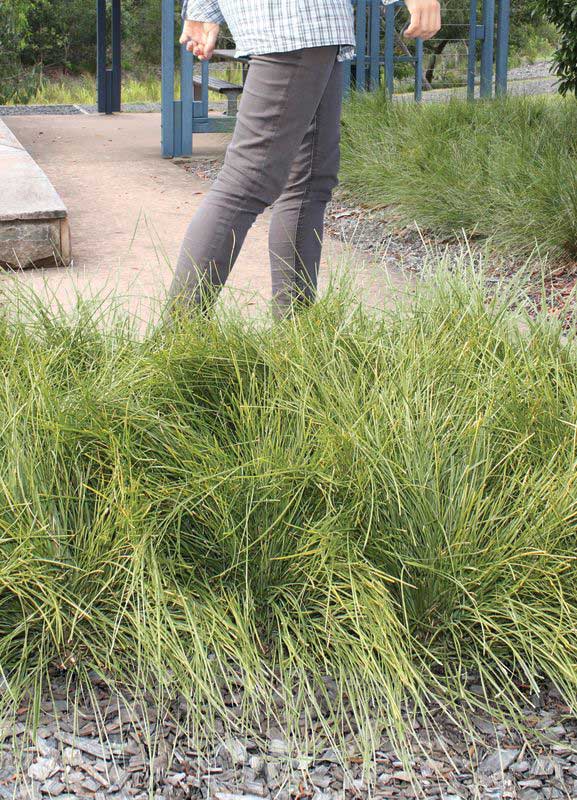Are you a landscape architect or garden designer who values safety and visibility? Have you ever wondered how the strategic use of low-growing native plants can create a safer environment for children near schools and childcare centres? Are you worried that means you won’t be able to create interest in your gardens without the height you’ve been allowed in other garden beds?
Dive into this guide to discover how to create captivating, functional spaces with unobstructed sightlines. We’ll even go over a few of the best compact ground covers, hedges and strappy plants that won’t obstruct visibility.
Visibility is important for parents to keep an eye on their kids in a playground setting. This plant is Evergreen Baby™ Lomandra labill ‘LM600’ PBR.
The Interplay of Visibility and Landscape Design
Safety First
Safety is a fundamental consideration in landscape design. Unobstructed sightlines minimise accidents and promote safety, especially near traffic. Low-profile vegetation allows for a clear view, especially important near childcare centres, school grounds and busy streets. By choosing low-growing plants, landscape architects can ensure that pedestrians and drivers have a clear line of sight, reducing the risk of accidents.
Aesthetics and Functionality
While ensuring safety, visibility also contributes to the overall aesthetic appeal and functionality of a landscape. A well-planned design with low-growing plants can create an open, welcoming atmosphere while serving practical purposes. These plants can define borders, create visual interest, and even serve as ground cover to control erosion.
Maintenance for Right Plants in the Right Place
Growth Trajectories
You need to consider the amount of visibility you need when choosing your plants. In some contexts, 1m still allows for plenty of visibility. In other contexts, low-growing means 40cm or lower.
Shrubs can add texture and colour to landscapes, but their growth can pose challenges. Regular maintenance may be necessary to manage their height and spread and keep sightlines clear.
Avoid plants with a larger mature height, and instead opt for more compact varieties. While it’s possible to prune plants, you’ll be fighting harder than if you choose a plant with a mature height that fits your space.
For instance, while Lomandra hystrix is a visually striking plant, its height of up to 1.m can obstruct views in areas such as childcare centre car parks. Compact variants of the same genus or other low-growing alternatives might be better suited for such scenarios.
Consider your maintenance budget, as well. How resource-intensive are your chosen plants? Will they require constant feeding, watering and pruning? Or are they resilient and slow-growing, getting by with minimal help and pruning?
Plant Habits Ideal for Sightline Preservation
Prostrate Shrubs
Prostrate shrubs, with their ground-hugging growth habit and sprawling nature, are excellent candidates for sightline preservation. They can create a lush, green carpet without obstructing views. However, even these low-growers need occasional pruning, especially around the edges, to prevent them from spreading into walkways or other areas.
Compact Strappy Leaf Plants
Compact strappy leaf plants, with their tidy growth habits and minimal height, also contribute to preserving sightlines. They provide structure and texture to the landscape without obstructing visibility. Additionally, their low maintenance requirements make them a favourite choice among landscape architects.
Groundcover Species
Groundcover species are a fantastic addition to any landscape design aiming to preserve sightlines. With their low-growing nature, they spread horizontally, creating a lush, green carpet that adds depth and texture to the landscape without obstructing views. Their dense growth helps prevent soil erosion from rain droplets, making them an environmentally friendly choice for landscapes.
Dwarf Cultivars of Shrub Species
Dwarf cultivars offer all the beauty of their taller counterparts while maintaining a compact size conducive to clear sightlines. These shrubs have been bred to grow smaller, making them ideal for areas where visibility is prioritised.
Suggested Low-Growing Native Plants for Unobstructed ViewsCherry Cluster™ Grevillea rhyolitica x juniperina ‘TWD01’ PBR
The Cherry Cluster™ Grevillea is a semi-prostrate ground cover with clean, tidy foliage and showy cherry flowers. It’s a very tough plant, drought and frost tolerant down to -5°C. This plant prefers full sun to part shade and well-drained soils. Avoid soils with a pH above 7. Prune every 2-3 years if required. Find more information here.
Better John™ Callistemon viminalis ‘LJ1’ PBR
Better John™ Callistemon is a compact shrub that produces vibrant red bottle-brush flowers in spring. This plant is low-maintenance and drought-tolerant once established. It prefers full sun or partial shade and well-drained soil. This Callistemon requires pruning every couple of years. More details can be found here.
Better John bottlebrush plants are great for visibility. The only downside is that their blooms are bee-attractors, so maybe don’t plant this one too close to a playground.
Little Jess™ Dianella caerulea ‘DCMP01’ PBR
Little Jess™ Dianella is a compact, clumping plant with deep blue flowers in spring. It’s drought and frost-tolerant, and it prefers full sun to 50% shade. This plant requires minimal maintenance and only needs to be pruned every 3-5 years. Learn more about this plant here.
Evergreen Baby™ Lomandra labill ‘LM600’ PBR
Evergreen Baby™ Lomandra is a compact, fine leaf form which remains evergreen in most situations. This hardy plant prefers full sun to heavy shade and tolerates frost and drought. It requires little to no pruning. More information is available here.
Pink Fusion™ Scaevola spp. ‘PFS200’ PBR Intended
Pink Fusion™ Scaevola is a dense ground cover with vibrant pink fan-shaped flowers. It’s a robust plant that thrives in full sun and well-drained soil. This plant requires occasional pruning to maintain a compact form. Find more details here.
Aussie Rambler™ Carpobrotus glaucescens ‘CAR10’ PBR
Aussie Rambler™ pigface is a hardy Australian native groundcover featuring large pink flowers. It’s highly drought and frost tolerant, preferring full sun to light shade. This plant requires minimal maintenance, but occasional pruning can prevent it from overgrowing onto walkways. Learn more about this plant here.
Blue Horizon™ Eremophila glabra prostrate ‘EREM1’ PBR
Blue Horizon™ Eremophila is a compact shrub with blue-grey foliage and purple-blue flowers. It’s a tough plant that prefers full sun and well-drained soils. Pruning is needed every few years to maintain a dense, compact shape. Find more details here.
Strategies for Incorporating Low-Growing Flora in Landscape Design
Design Planning
Design planning that considers the growth patterns and maintenance needs of plant species is essential. Following the “right plant, right place” principle ensures each species thrives and serves its intended role within the design.
Maintenance
Regular maintenance is crucial to keep these plants low-profile. Opting for low-maintenance species can save significant time and effort, making the landscape easier to manage in the long term.
Professional Consultation
Consulting with fellow landscape architects or horticultural experts can provide valuable insights and advice tailored to specific design needs and conditions. These professionals can suggest suitable plant species, design strategies, and maintenance practices.
Pruning Practices Near Walkways and Roads
The Need for Pruning
Proper pruning near walkways and roads creates safer urban spaces. Overgrown vegetation can obstruct sightlines, reduce accessibility, and potentially create unsafe conditions for pedestrians and motorists alike.
However, proper pruning isn’t as simple as it may sound on the surface. Improper pruning can lead to decreased tree health and branch failure. And unsafe pruning practices around pedestrians and motorways can lead to catastrophic accidents.
Pruning Risks and Regulations
For example, pruning around utility lines and larger trees carries risk. Pruning roots and branches can compromise the stability of a tree.
Depending on the circumstances, pruning without a permit may be illegal. In Australia, any work within the state road or highway, including planting, cutting, trimming, pruning, or removal of plants, requires appropriate permissions and traffic control.
If you’re pruning around a cul de sac, some flashing lights, traffic cones, and “men at work” signs may be appropriate.
Traffic Control for Contractors
Contractors performing pruning work alongside busy roads must implement effective traffic control measures to ensure the safety of road users and workers. In Australia, the guidelines outlined by Safe Work Australia provide comprehensive advice on managing traffic in construction work.
https://www.safeworkaustralia.gov.au/system/files/documents/1703/traffic-management-general-guide.pdf
Plant Growth Habits and Pruning Requirements
Different plants have distinct growth habits and, consequently, varying pruning requirements. For example, Better John Callistemon needs hedge pruning every couple of years while other plants will need much more frequent pruning.
Ground cover plants, with their sprawling habit, may grow over the road or walkway, necessitating more frequent pruning to prevent encroachment. Shrubs can obstruct more horizontal and vertical space, potentially making the roadway or walkway unsafe.
Hedge pruning is a common method for controlling the size of ground covers and hedges alike. When it comes to strappy plants, a better approach may be to remove rhizomes to control the size of plants, with a hard prune back to the base every few years.
Conclusion
In conclusion, the discerning selection of low-growing flora can significantly enhance sightlines, safety, and aesthetics in various settings. By understanding the growth habits and maintenance needs of these plants, we can ensure they serve their intended purpose, contributing to both the beauty and safety of our landscapes.

